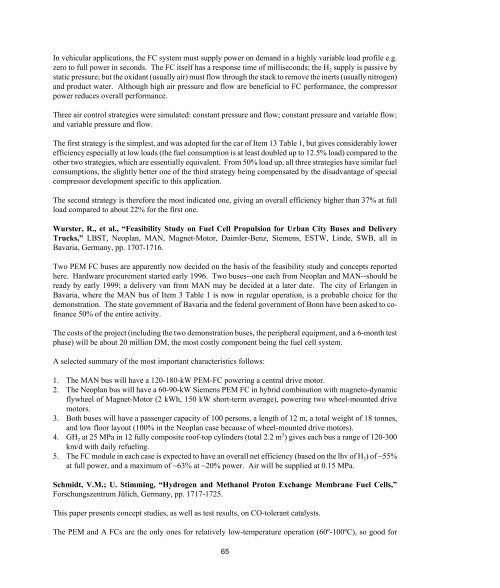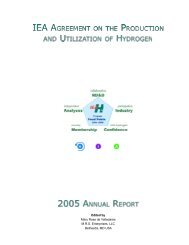Technology Status of Hydrogen Road Vehicles
Technology Status of Hydrogen Road Vehicles
Technology Status of Hydrogen Road Vehicles
You also want an ePaper? Increase the reach of your titles
YUMPU automatically turns print PDFs into web optimized ePapers that Google loves.
In vehicular applications, the FC system must supply power on demand in a highly variable load pr<strong>of</strong>ile e.g.<br />
zero to full power in seconds. The FC itself has a response time <strong>of</strong> milliseconds; the H 2 supply is passive by<br />
static pressure; but the oxidant (usually air) must flow through the stack to remove the inerts (usually nitrogen)<br />
and product water. Although high air pressure and flow are beneficial to FC performance, the compressor<br />
power reduces overall performance.<br />
Three air control strategies were simulated: constant pressure and flow; constant pressure and variable flow;<br />
and variable pressure and flow.<br />
The first strategy is the simplest, and was adopted for the car <strong>of</strong> Item 13 Table 1, but gives considerably lower<br />
efficiency especially at low loads (the fuel consumption is at least doubled up to 12.5% load) compared to the<br />
other two strategies, which are essentially equivalent. From 50% load up, all three strategies have similar fuel<br />
consumptions, the slightly better one <strong>of</strong> the third strategy being compensated by the disadvantage <strong>of</strong> special<br />
compressor development specific to this application.<br />
The second strategy is therefore the most indicated one, giving an overall efficiency higher than 37% at full<br />
load compared to about 22% for the first one.<br />
Wurster, R., et al., “Feasibility Study on Fuel Cell Propulsion for Urban City Buses and Delivery<br />
Trucks,” LBST, Neoplan, MAN, Magnet-Motor, Daimler-Benz, Siemens, ESTW, Linde, SWB, all in<br />
Bavaria, Germany, pp. 1707-1716.<br />
Two PEM FC buses are apparently now decided on the basis <strong>of</strong> the feasibility study and concepts reported<br />
here. Hardware procurement started early 1996. Two buses--one each from Neoplan and MAN--should be<br />
ready by early 1999; a delivery van from MAN may be decided at a later date. The city <strong>of</strong> Erlangen in<br />
Bavaria, where the MAN bus <strong>of</strong> Item 3 Table 1 is now in regular operation, is a probable choice for the<br />
demonstration. The state government <strong>of</strong> Bavaria and the federal government <strong>of</strong> Bonn have been asked to c<strong>of</strong>inance<br />
50% <strong>of</strong> the entire activity.<br />
The costs <strong>of</strong> the project (including the two demonstration buses, the peripheral equipment, and a 6-month test<br />
phase) will be about 20 million DM, the most costly component being the fuel cell system.<br />
A selected summary <strong>of</strong> the most important characteristics follows:<br />
1. The MAN bus will have a 120-180-kW PEM-FC powering a central drive motor.<br />
2. The Neoplan bus will have a 60-90-kW Siemens PEM FC in hybrid combination with magneto-dynamic<br />
flywheel <strong>of</strong> Magnet-Motor (2 kWh, 150 kW short-term average), powering two wheel-mounted drive<br />
motors.<br />
3. Both buses will have a passenger capacity <strong>of</strong> 100 persons, a length <strong>of</strong> 12 m, a total weight <strong>of</strong> 18 tonnes,<br />
and low floor layout (100% in the Neoplan case because <strong>of</strong> wheel-mounted drive motors).<br />
4. GH 2 at 25 MPa in 12 fully composite ro<strong>of</strong>-top cylinders (total 2.2 m 3 ) gives each bus a range <strong>of</strong> 120-300<br />
km/d with daily refueling.<br />
5. The FC module in each case is expected to have an overall net efficiency (based on the lhv <strong>of</strong> H 2) <strong>of</strong> ~55%<br />
at full power, and a maximum <strong>of</strong> ~63% at ~20% power. Air will be supplied at 0.15 MPa.<br />
Schmidt, V.M.; U. Stimming, “<strong>Hydrogen</strong> and Methanol Proton Exchange Membrane Fuel Cells,”<br />
Forschungszentrum Jülich, Germany, pp. 1717-1725.<br />
This paper presents concept studies, as well as test results, on CO-tolerant catalysts.<br />
The PEM and A FCs are the only ones for relatively low-temperature operation (60º-100ºC), so good for<br />
65













